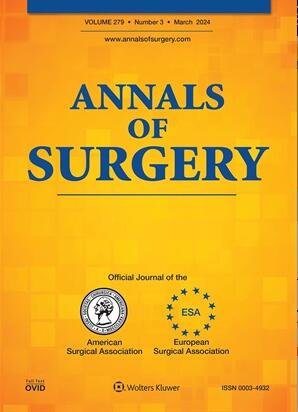Intermittent Inflow Occlusion in Robotic Right Donor Hepatectomy: A Randomised Controlled Trial.
IF 7.5
1区 医学
Q1 SURGERY
引用次数: 0
Abstract
OBJECTIVE To assess the safety and efficacy of intermittent inflow occlusion (IIO) during robotic right donor hepatectomy (RDH) for adult living donor liver transplantation. SUMMARY BACKGROUND DATA Although evidence supports minimally invasive donor hepatectomy, its adoption by surgeons remains limited. Key challenges include bleeding during parenchymal transection and prolonged warm ischemia during graft extraction, resulting in morbidity in both the donor and recipient. METHODS Between April 2022 and June 2023, out of 123 donors suitable for RDH, 113 were randomised to undergo robotic RDH with (n=56) or without (n=57) IIO. The primary endpoint was the blood loss during robotic RDH. The secondary end points included peak levels of bilirubin, aspartate aminotransferase (AST), alanine aminotransferase (ALT), INR and complications in donors and recipients. Additionally, peak lactate levels and the need for blood transfusion were assessed in donors. RESULTS The mean duration of IIO was 42.48±11.21 minutes .Blood loss during parenchymal transection (235 (186.25 - 375) vs. 295 (235 - 475),P=0.006) and total blood loss (275 (212.5 - 430) vs. 330 (272.5- 520),P=0.018) were significantly lower among donors in the IIO arm. In recipients belonging to IIO arm, peak ALT (P=0.032) and INR (P=0.012) were significantly low. Although statistically similar, the peak AST (P=0.064) and acute kidney injury (1,P=0.061) in the IIO arm among recipients were also less. Other perioperative outcomes including complications in donors/recipients and overall mortality in recipients remained comparable. CONCLUSION IIO during robotic RDH is safe. It led to reduced blood loss among donors and improved graft parameters in recipients during the immediate postoperative period.机器人右侧供体肝切除术中的间歇性血流闭塞:随机对照试验
目的评价成人活体肝移植机器人右供肝切除术(RDH)中间歇性血流阻塞(IIO)的安全性和有效性。背景数据尽管有证据支持微创供肝切除术,但其在外科医生中的应用仍然有限。主要的挑战包括实质横断时的出血和移植物提取时的长时间热缺血,导致供体和受体的发病率。方法在2022年4月至2023年6月期间,在123名适合RDH的献血者中,113名随机分为有(n=56)或没有(n=57) IIO的机器人RDH。主要终点是机器人RDH过程中的出血量。次要终点包括胆红素、天冬氨酸转氨酶(AST)、丙氨酸转氨酶(ALT)的峰值水平、INR和供体和受体的并发症。此外,对献血者的乳酸峰值水平和输血需求进行了评估。结果IIO组的平均持续时间为42.48±11.21 min,实质横断失血量(235 (186.25 ~ 375)vs. 295 (235 ~ 475),P=0.006)和总失血量(275 (212.5 ~ 430)vs. 330 (272.5 ~ 520),P=0.018)显著低于IIO组。在IIO组,ALT峰值(P=0.032)和INR (P=0.012)显著降低。虽然统计学上相似,但IIO组的AST峰值(P=0.064)和急性肾损伤(1,P=0.061)也更少。其他围手术期结果包括供体/受体并发症和受体总体死亡率保持可比性。结论机器人RDH过程中io是安全的。它减少了献血者的失血,改善了术后受者的移植物参数。
本文章由计算机程序翻译,如有差异,请以英文原文为准。
求助全文
约1分钟内获得全文
求助全文
来源期刊

Annals of surgery
医学-外科
CiteScore
14.40
自引率
4.40%
发文量
687
审稿时长
4 months
期刊介绍:
The Annals of Surgery is a renowned surgery journal, recognized globally for its extensive scholarly references. It serves as a valuable resource for the international medical community by disseminating knowledge regarding important developments in surgical science and practice. Surgeons regularly turn to the Annals of Surgery to stay updated on innovative practices and techniques. The journal also offers special editorial features such as "Advances in Surgical Technique," offering timely coverage of ongoing clinical issues. Additionally, the journal publishes monthly review articles that address the latest concerns in surgical practice.
 求助内容:
求助内容: 应助结果提醒方式:
应助结果提醒方式:


